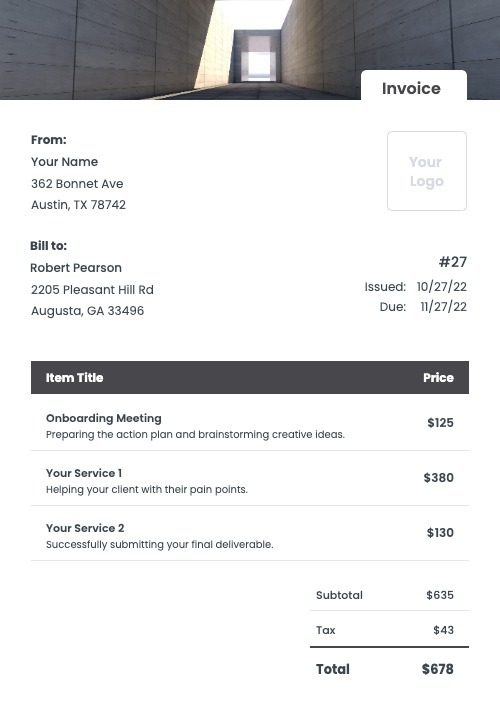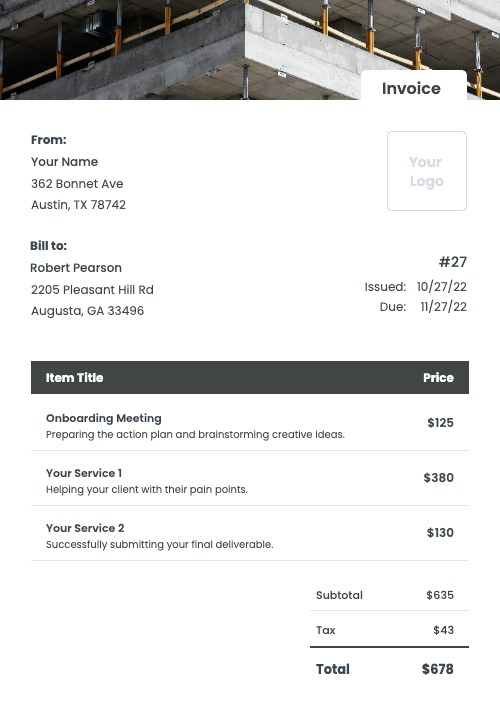Concrete Invoice Templates
Tired of creating tedious concrete invoices by hand? With Kosmo, you can create beautiful, professional invoices in minutes using a custom concrete invoice template.
Get paid faster with online payments, automatic late payment reminders, and more. Plus, our templates are free to use, so you can save time and money.
Create Your Own Invoices For Free



How To Create A Concrete Invoice That Gets Paid
As a concrete contractor, you provide a vital service to businesses and homeowners. Your clients rely on you to pour and finish concrete to create durable, long-lasting surfaces.
To ensure that you are fairly compensated for your work, it is important to itemize your services in your invoices. For example, if you are pouring a concrete slab, your invoice might include items such as “excavation”, “forms and rebar”, “pouring concrete”, “finishing concrete”, and “clean up”.
By itemizing your services, you can make sure that your clients understand exactly what they are paying for, and you can ensure that you are fairly compensated for your work.

Creating an invoice step by step
- Download a template
- Change the colors of the invoice
- Add your own company information
- Add your client’s details
- Add the line items
- Calculate applicable taxes and discounts
- Check the final amount
- Add your payment terms, notes and a due date
- Send the invoice to your client
- Keep track of paid and unpaid invoices
Or use Kosmo to make the process simple and fast.
Creating A Concrete Invoice With Kosmo

1. Style and customize
Choose an invoice template that suits your industry and style. Next, adjust the invoice by changing the colors and by uploading your logo to match your brand.

2. Enter line items
Enter all items you’d like to bill to the client. Add a title and an optional description to provide more details regarding the work completed. Lastly, add the cost for each item.

3. Send the invoice
Choose your preferred payment method and add any terms & conditions. Hit “send” to email the invoice and receive a notification once your client has paid the invoice.
Get paid on time, every time.
Create professional invoices with Kosmo and level up your business today.
Why Should You Use A Concrete Invoice Template?
When you issue an invoice, you’re essentially creating a legal document that binds the customer to pay you for the goods or services you’ve provided. This document should be clear, concise, and easy to understand so that there’s no confusion on the customer’s end about what they’re being invoiced for and how much they owe.
A concrete invoice template can help ensure that your invoices are professional and easy to understand. A good template will include all of the necessary information that should be included on an invoice, such as your company name and contact information, the customer’s name and contact information, a clear description of the goods or services being billed, the prices for those goods or services, the payment terms, and the date of the invoice.
Using a template can also help you save time when creating invoices, as you won’t need to start from scratch each time you issue one. Simply open up the template, fill in the relevant information, and hit send. This can be a huge time-saver, especially if you’re issuing a large number of invoices on a regular basis.
Overall, using a concrete invoice template can help you create professional, easy-to-understand invoices that will ensure timely payment from your customers.

Concrete Invoice Requirements Checklist
- A unique invoice number.
- The payment due date.
- The date when the invoice was issued.
- Your name and/or company name and your contact information.
- Your client’s name and/or company name and contact information.
- A detailed line-by-line break down of your services and products.
- Any applicable taxes and discounts.
- The calculated total price of the invoice.
- Accepted payment methods, for example credit card, check, PayPal and others.
- Additional notes about payment terms, late fees and more.
When Is The Right Time To Send My Concrete Invoice?
The answer to this question depends on a number of factors, including the terms of your contract with the customer, the payment terms of your invoices, and your company’s internal billing and invoicing policies. In general, it is best to send an invoice as soon as the work is completed and you have all of the necessary information to do so. This will minimize the chance that the customer will forget to pay or that you will have to chase them for payment. However, if you are using a progress billing system, you may need to wait until a certain milestone is reached before sending the invoice. For example, if you are building a house, you may not send the first invoice until the foundation is complete. Ultimately, it is up to you to determine when the right time is to send your concrete invoice.
Kosmo vs Manual Invoices
| Feature | Kosmo | Template |
|---|---|---|
| Create professionally designed invoices. | ||
| Securely send invoices to clients via email. | ||
| Get paid faster with online payments. | ||
| Automatically calculate invoice totals. | ||
| Track payments and invoices in real-time. | ||
| Receive automatic reminders for overdue invoices. | ||
| Access your invoices from anywhere in the world. | ||
| Get Started For Free |
How Invoicing Software Can Help You
Save Time
Invoicing software can help you save a lot of time. It allows you to create and send beautiful invoices quickly and easily. This means that you can spend less time on administrative tasks, and more time on your work.
Get Paid Faster
An invoicing software like Kosmo can help you get paid faster. When you send invoices electronically, you can often get paid quicker than if you had to wait for a check to arrive in the mail.
Organize Your Business
When all of your invoices are stored in one place, it is easier to keep track of what is owed and when payments are due. This can help you avoid getting paid late.
Professional Design
With invoicing software, you can often choose from a variety of templates and designs. This means that your invoices will look professional and polished. So take your pick and make your business look great.
Get paid on time, every time.
Create professional invoices with Kosmo and level up your business today.
FAQs (Frequently Asked Questions)
Who needs to use a concrete invoice?
A concrete invoice is typically used by construction companies and other businesses that deal with physical goods or services. The main purpose of a concrete invoice is to provide a clear and itemized breakdown of the costs associated with a project or transaction. This allows for proper accounting and helps to avoid any misunderstandings or disputes that could arise.
There are a few key elements that should be included on a concrete invoice. The first is a clear description of the work that was performed or the goods that were provided. This should be as specific as possible to avoid any confusion. The second is the cost of each item or service, which should be listed in a clear and easy to understand manner. Finally, the invoice should also include the total cost of the project or transaction.
Overall, a concrete invoice is a valuable tool for businesses that deal with physical goods or services. It helps to provide a clear and itemized breakdown of costs, which can avoid misunderstandings and disputes.
How do you bill for concrete work?
It depends on a number of factors, including the type of concrete work being performed, the size of the job, the location of the job, and the specific billing arrangement that has been made between the contractor and the customer. In general, however, concrete work is typically billed either by the hour or by the square foot.
If the concrete work being performed is part of a larger construction project, then the contractor will usually bill the customer for the concrete work as part of the overall project invoice. This is often the case for projects like building a new home or office, where the concrete work is just a small part of the overall job. In these cases, the customer will usually be given an estimate for the total cost of the project, with the concrete work being just a portion of that total.
For smaller jobs, or for jobs where the concrete work is the primary focus, the contractor will often bill by the hour or by the square foot. This is often the case for projects like concrete driveway or patio installation, where the job is relatively small and the concrete work is the main focus. In these cases, the customer will be given an estimate for the total cost of the job, with the concrete work being the majority of that total.
How to create a concrete invoice?
Invoices are an important part of any business transaction – they act as a record of what was purchased, by whom, and for how much. Creating a concrete invoice is simple, but there are a few key details that must be included to make it valid.
First, the invoice must have a unique identifier, typically the date of the transaction and the name of the customer. This helps to ensure that the invoice can be matched to the correct purchase.
Next, the invoice must list the items or services that were purchased, along with the quantities and prices. This allows the customer to verify that they received what they paid for, and also provides a record for the business.
Finally, the invoice must include the total amount due, and any applicable taxes or fees. This ensures that the customer knows how much they need to pay, and that the business receives the correct amount.
How can I make my concrete invoice stand out?
When you are creating a concrete invoice, you want to make sure that it is clear, concise, and easy to understand. You also want to make sure that it stands out so that your customers will remember it. Here are some tips on how to make your concrete invoice stand out:
1. Use a unique color scheme.
2. Use a simple, yet eye-catching, layout.
3. Use your company logo and contact information prominently.
4. Use clear and concise language.
5. Highlight any discounts or special offers.
By following these tips, you can create a concrete invoice that will stand out and be remembered by your customers.
What are some tips for creating a concrete invoice?
1. Make sure to include the following information on your invoice:
-Your Business Name
-Your Address
-The Client’s Name
-The Client’s Address
-The Date
-Invoice Number
-Description of Services Provided
-The Total Cost of Services
-Any Applicable Taxes
-Your Payment Terms
-Your Business Logo
2. Be sure to send your invoice as soon as the job is completed. This will help ensure prompt payment.
3. Include a detailed description of the services provided. This will help avoid any confusion on what the client is being charged for.
4. Include your payment terms on the invoice. This will help avoid any misunderstandings on when the client is expected to pay.
5. Make sure the total cost is accurate. This will help build trust with your clients and avoid any issues with payment.
6. Include your business logo on the invoice. This will help make your business look professional and will make it easy for clients to remember your business in the future.
What are some common mistakes to avoid when creating a concrete invoice?
When creating a concrete invoice, there are a few common mistakes to avoid. First, be sure to include all relevant information such as the date, job site address, and a description of the work to be performed. Second, be sure to include the correct price for the work to be performed. If the price is too low, you may not be able to cover the costs of the job. Finally, be sure to include any special instructions or requests from the customer. These could include a request for a specific color or design, or a request for a rush delivery.